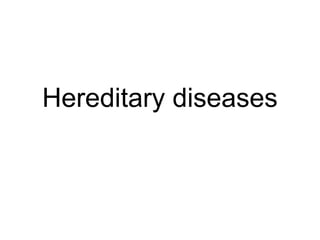There are several classes of hereditary diseases:
1) Diseases of simple genetic architecture are caused by a single gene and follow recognizable patterns of inheritance. They are usually rare.
2) Diseases of complex genetic architecture do not have clear patterns of inheritance and are influenced by multiple genes and the environment. They are more common.
3) Genetic disorders can be caused by abnormalities in chromosomes, single genes, or a combination of genetic and environmental factors. They result in conditions like cystic fibrosis, sickle cell anemia, muscular dystrophy, and Down syndrome. Changes in chromosome number, structure, or sex chromosomes can also cause genetic disorders.




























































































